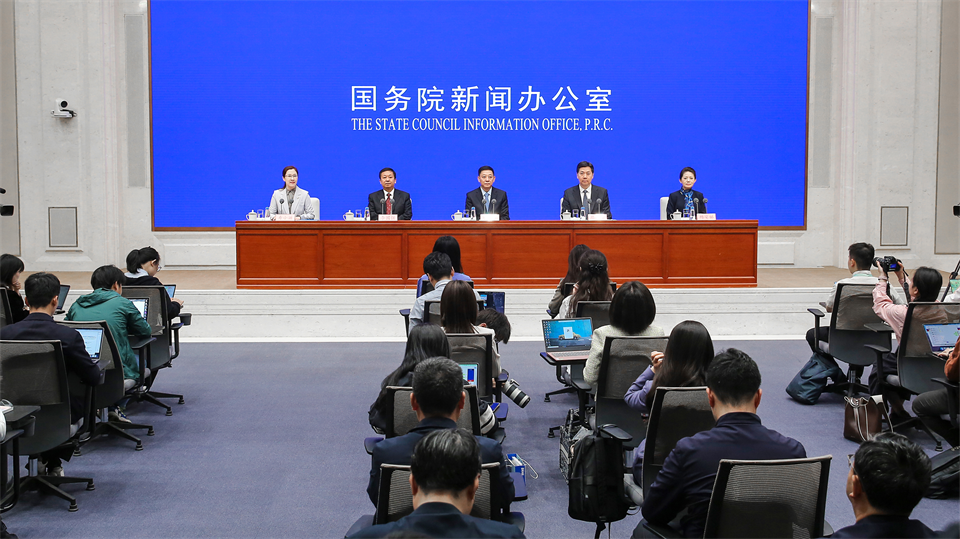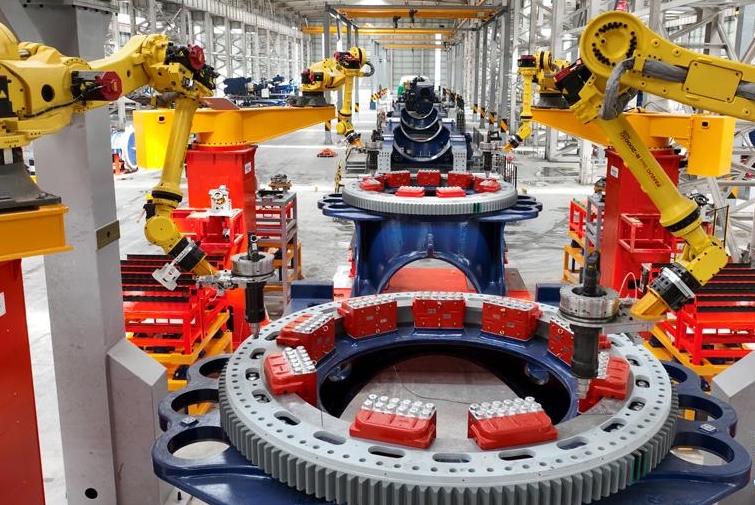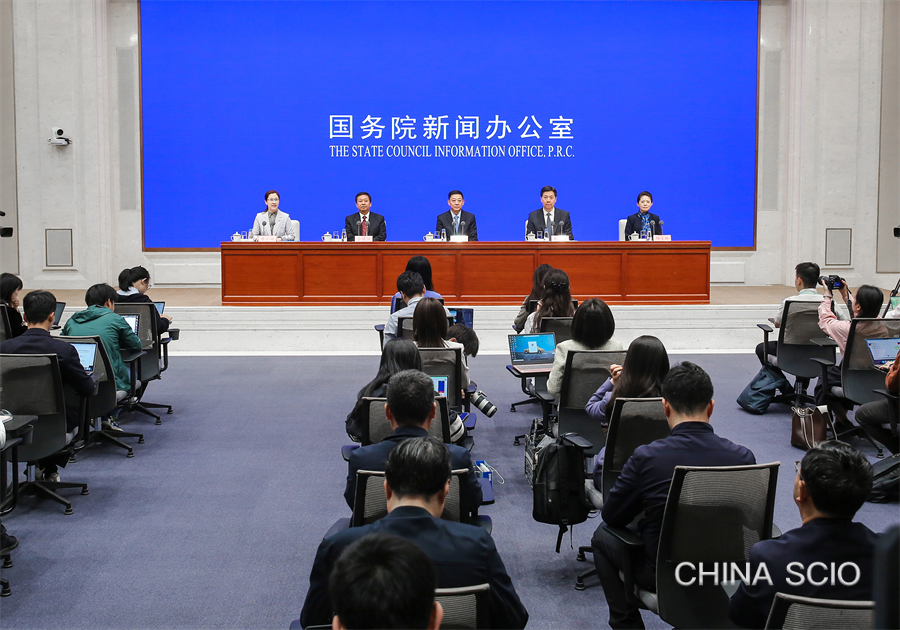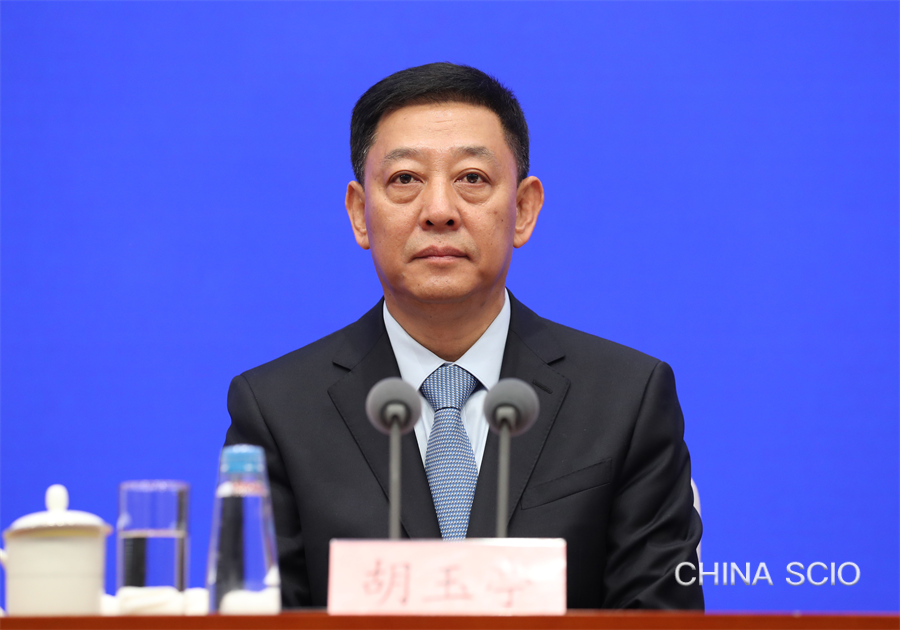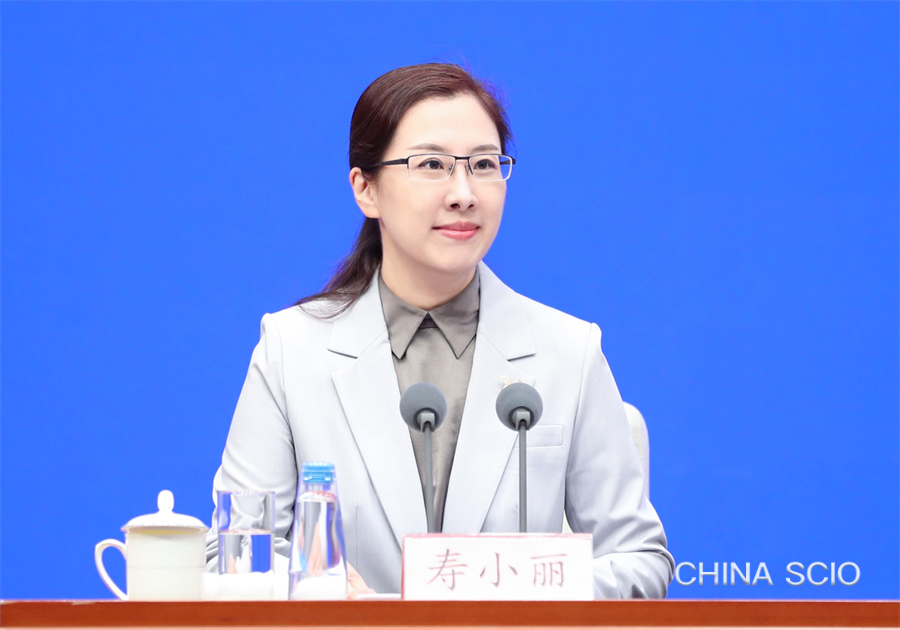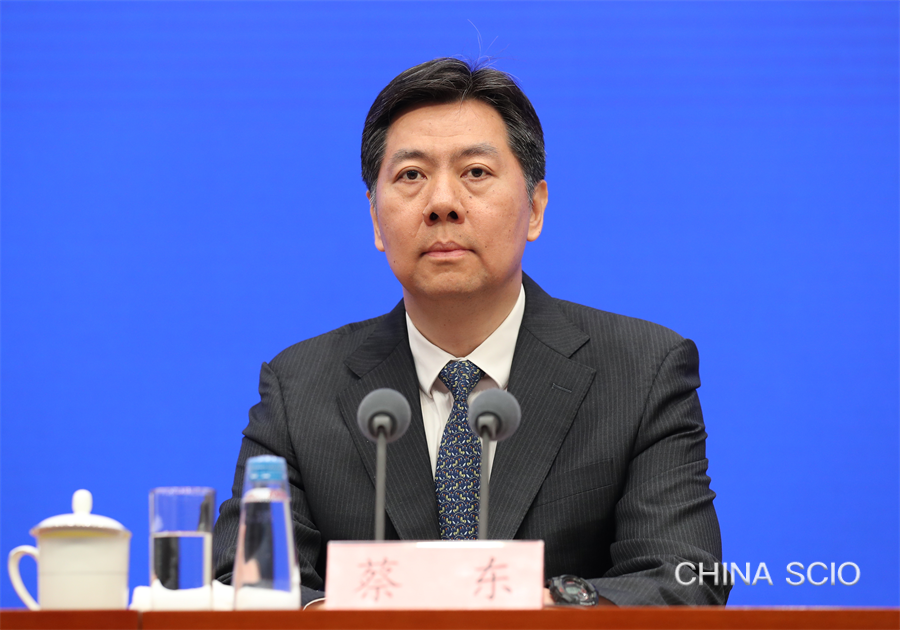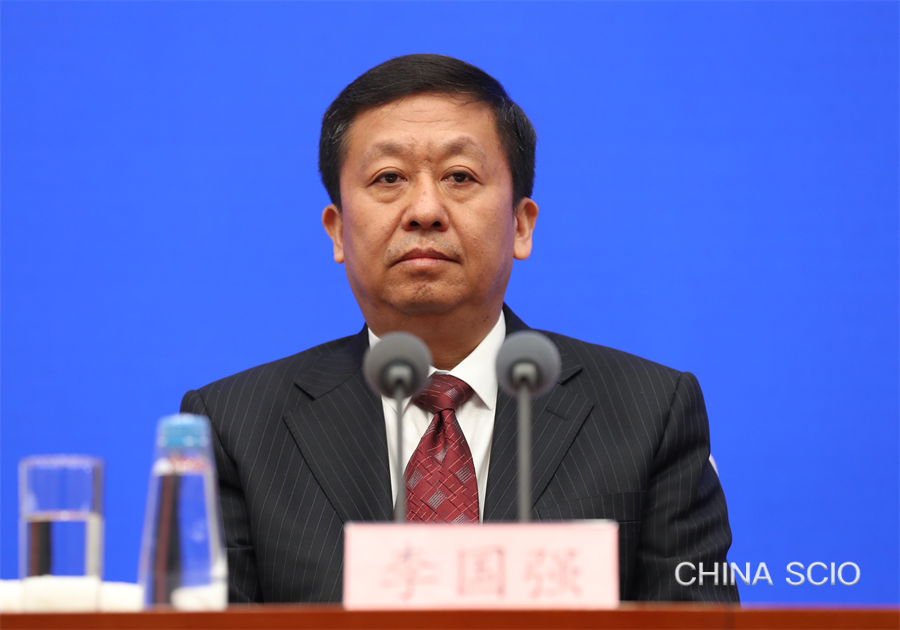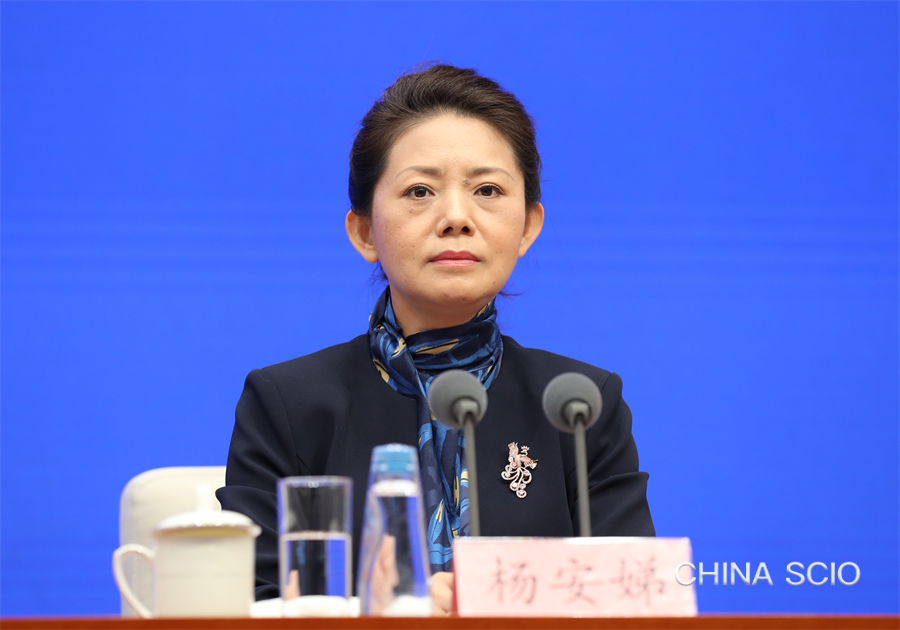.
Read in Chinese
Speakers:
Mr. Hu Yuting, deputy secretary of the Communist Party of China (CPC) Jilin Provincial Committee and governor of Jilin province
Mr. Cai Dong, a member of the Standing Committee of the CPC Jilin Provincial Committee and executive vice governor of Jilin province
Mr. Li Guoqiang, vice governor of Jilin province
Ms. Yang Andi, vice governor of Jilin province
Chairperson:
Ms. Shou Xiaoli, deputy director general of the Press Bureau of the State Council Information Office (SCIO) and spokesperson of the SCIO
Date:
April 22, 2024
Shou Xiaoli:
Ladies and gentlemen, good morning. Welcome to this press conference held by the State Council Information Office (SCIO). This is the 10th press conference in the series "Promoting High-Quality Development." Today, we are very pleased to be joined by Mr. Hu Yuting, deputy secretary of the Communist Party of China (CPC) Jilin Provincial Committee and governor of Jilin province, who will brief you on striving for new breakthroughs to revitalize Jilin in the new era and then take your questions. Also present today are Mr. Cai Dong, a member of the Standing Committee of the CPC Jilin Provincial Committee and executive vice governor of Jilin province, as well as two vice governors of the province, Mr. Li Guoqiang and Ms. Yang Andi.
Now, I'll give the floor to Mr. Hu Yuting.
Hu Yuting:
Ladies and gentlemen, friends from the media, good morning. I would like to start by extending my deep appreciation for your long-standing interest in and support for the revitalization and development of Jilin. It is also my pleasure to have the opportunity to brief you on this topic.
General Secretary Xi Jinping holds high expectations for the revitalization and development of Jilin. Since the 18th CPC National Congress, he has conducted three inspection tours in the province and put forward the important requirements for us to "shoulder new responsibilities, achieve new breakthroughs and make new accomplishments." This has drawn up a blueprint for Jilin's comprehensive revitalization, and injected strong impetus into the endeavor.
Bearing in mind such expectations, we have resolutely shouldered the important mission of safeguarding the nation's security in food, industry, energy, eco-system and national defense, ushering in a phase of accelerated revitalization and development. In 2023, Jilin's GDP saw year-on-year growth of 6.3%, outpacing the national GDP by 1.1 percentage points. In the first quarter of this year, the province's GDP growth rate hit 6.5%, again surpassing the national economic growth by 1.2 percentage points. With the growth rates of its multiple economic indicators ranking among the top in the country, Jilin has maintained a sound momentum of achieving stable growth while making further progress.
Jilin is not only a key industrial base in the country, but also a major farming province and one rich in ecological resources. Its industrialization started early, and it served as the cradle of the country's auto, chemical and film industries. Jilin has achieved numerous unprecedented national milestones and made key historic contributions to the nation.
On the new journey in the new era, we have kept this historical heritage in mind, carried forward our diligent traditions, and spared no effort to shore up weak links and embrace new challenges. We are poised to achieve new breakthroughs in Jilin's comprehensive revitalization.
Jilin's biggest advantage lies in its agricultural sector. Located within one of the world's three major chernozem soil regions, Jilin leads the nation in large-scale farming and agricultural mechanization. Its annual grain output has exceeded 40 billion kilograms for three consecutive years, and its pioneering role in advancing modern agriculture has been further consolidated.
Jilin's primary strength stems from its manufacturing industry. "Made-in-Jilin" products like vehicles from FAW Group , high-speed trains from CRRC Changchun Railway Vehicles, and satellites from Chang Guang Satellite Technology are well-recognized across the country. Notably, the world's first hydrogen-powered urban train completed its test run here. The Jilin-1 satellites have become the world's largest sub-meter-level commercial remote sensing satellite constellation.
Jilin's innovation strength comes from its edge in science, education and humanities. It is home to 66 colleges and universities, 106 research institutes, and numerous national strategic sci-tech facilities. It ranks fifth nationwide in terms of the scientific research material conditions index , and boasts huge potential for innovation-driven development.
Jilin has made "green" a defining feature of its ecological environment. It boasts not only lucid waters and lush mountains, but also abundant ice and snow resources. Jilin ranks top in the country in the comprehensive evaluation of forest resources. In addition, it is rich in wind and photovoltaic power, and also enjoys a vast expanse of land, providing a unique advantage for the development of new energy industries.
On the new journey in the new era, we will seize the opportunities and work to the best of our abilities. There is much that we can do in achieving new breakthroughs in Jilin's comprehensive revitalization. Specifically, we aim to make breakthroughs in the following fields:
First, we will spur industrial innovation by making sci-tech innovations, and develop new quality productive forces in accordance with Jilin's local conditions. We will implement a sci-tech innovation mechanism, making organized efforts to achieve sci-tech breakthroughs and foster their applications. By doing so, we will address the needs of the industrial sector, further pool strength to make sci-tech breakthroughs in this regard, and expedite their application. We will ramp up efforts to develop the "four key clusters": big agriculture , big equipment , big tourism and big data. We will bolster the "six emerging industries": new energy, new materials, new medicine, new healthcare, new services and new e-commerce. In addition, we will enhance the construction of "new facilities in four categories": new infrastructure, new environment, new lifestyle and new consumption pattern. With such efforts, we aim to develop a high-quality development system and a high-level living system.
Second, we will focus on the development of modern agriculture and expedite efforts to enhance Jilin's agricultural capabilities. We will prioritize the nation's food security and adopt an all-encompassing approach to agriculture and food . In accordance with Jilin's advantages in natural resources, we will strengthen chernozem soil protection and improve saline-alkali land. In addition, we will promote the application of smart agricultural machinery and bio-breeding technologies, foster the production of green and organic food, and develop a modern agriculture industry with a value surpassing the 1-trillion-yuan ($138 billion) mark.
Third, we prioritize ecological progress, insist on green development, and pioneer in building a beautiful China. We will view lush mountains and lucid waters as invaluable assets and firmly safeguard ecological security, better preserving the eco-environment by developing eco-tourism and vice versa. We plan to create world-class ice and snow brands and tourism attractions for both winter and summer. By 2027, tourism revenue is expected to exceed 1 trillion yuan. We will proactively develop the clean energy industry and accelerate efforts to forge a "green hydrogen+" industrial cluster with global competitiveness.
Fourth, we have comprehensively deepened reforms, and elevated the level of opening-up and cooperation. We will work unswervingly both to consolidate and develop the public sector and to encourage, support, and guide development of the non-public sector. We will empower development and increase efficiency by lifting restrictions and unleashing people's ingenuity. While deepening and improving reforms of state-owned enterprises (SOEs), we will also vigorously develop the private sector. We will continue to improve the business environment, increasingly conduct approval procedures online, and make "getting things done without having to rely on personal connections" the standard practice. We aim to deeply involve ourselves in the Belt and Road Initiative and build Jilin into an important gateway for China's opening-up in the north and a hub for cooperation among northeastern Asian countries.
Fifth, we are promoting the high-quality development of the population and enhancing talent support. We will comprehensively improve the quality of the population, create more favorable conditions for innovation and entrepreneurship, offer more support for talent, and expand employment opportunities in various industries. Our goal is to attract more than 60% of college graduates to stay in Jilin for work, thus cementing the positive trend of a net inflow of talent and population into the province.
We have experienced a lot and are now facing a new horizon. It's time for Jilin to realize comprehensive revitalization in the new era. This is highly anticipated. We welcome our friends from the media to visit Jilin again and continue to support this northeastern province.
That's all from me for now. Thank you all.
_ueditor_page_break_tag_
Shou Xiaoli:
Thank you, Mr. Hu. Now, the floor is open for questions. Please identify your news agency before raising your questions.
CNR:
I have noticed that Jilin's total grain output has exceeded 40 billion kilograms for three years in a row. So, as an important province for agriculture and grain production, how does Jilin plan to fulfill its role in firmly safeguarding food security in China? Thank you.
Hu Yuting:
Thank you for paying attention to Jilin's agricultural development. Jilin has been a frontrunner in terms of grain production in China. It is located in one of the three major black soil areas in the world and is renowned for its advantageous conditions for cultivating corn and rice. It is also endowed with vast plains and boundless stretches of land for developing large-scale modern agriculture.
You just mentioned that Jilin's total grain output has exceeded 40 billion kilograms for three consecutive years. Last year, Jilin's total grain output reached 41.865 billion kilograms, rising to the fourth position in the country. The per-unit output ranked first among major grain-producing provinces. More than 90% of the grain output was commercialized, and more than 50% of the grain output was allocated outside the province. Under the new initiatives of increasing grain production capacity by 50 million metric tons, Jilin is assigned to accomplish one-fifth of the total increase, or 10 billion kilograms. As a result, Chinese citizens will be able to enjoy more grain produced in Jilin.
These are the due responsibilities we need to shoulder to realize the goal of continuing to safeguard national food security. The task is weighty, and the solution lies in fostering new quality productive forces in agriculture and in raising total factor productivity through the following measures:
First, we will increase fertile farmland. Jilin has nearly 100 million mu (6.67 million hectares) of black soil land, often referred to as the "giant panda of farmland." We have leveraged our scientific and technological strengths to better protect and utilize black soil, and ensure grain output. We have promoted new, eco-friendly farming methods, such as returning plant stalks to fields and implementing no-tillage planting. Additionally, we have renovated and improved medium- and low-yield fields. This year, we aim to create 666,667 hectares of high-standard croplands, striving to be the first to upgrade all basic croplands to high-standard ones. We will also develop saline and alkaline lands as backup resources to expand agricultural production, expecting a 133,333-hectare increase in fields. We aim to add 4.3 billion kilograms of grain output by sustainably utilizing farmlands to enhance grain production capacity.
Second, we will cultivate quality seeds. Seeds are dubbed as the "chips" of agriculture. We have actively promoted the revitalization of the seed industry and established breeding platforms for key crops such as corn, rice and soybeans. We advocate for the integration of seed breeding, propagation and popularization to expand the use of quality seeds. Thanks to the use of fine seeds, per-unit yields have increased, resulting in a 3 billion-kilogram output increase.
Third, we will utilize high-quality equipment. The overall mechanization rate in crop production in Jilin has reached 94%, which is 20 percentage points higher than the national level. Moving forward, we will focus on developing high-end, smart agricultural machinery, including powerful equipment suitable for flatlands, small-sized machinery for hilly terrain, and innovative solutions that address market gaps, particularly unmanned ones. Mechanization improves efficiency and reduces losses, resulting in a 150 million-kilogram increase in output.
Fourth, we will adopt useful measures. Fertigation and compact planting enable a 30% increase in output per mu (0.067 hectares). We promote commercial agricultural services, provide support to new types of agribusinesses, and expand large-scale, intensive, and standardized operations. Through the utilization of new technologies and services, output has increased by 3.75 billion kilograms.
Lastly, we will develop smart agriculture. We have established digital platforms for agricultural development, promoted soil testing and formulated fertilization plans, deciphered the secrets of soil composition, and expanded the application scenarios of the Jilin-1 satellite to include soil moisture content monitoring, early warning of crop diseases and pests, and meteorological services. This will empower large-scale modern agriculture with smart technologies.
We are confident in maintaining a strong growth momentum of grain production. The province's expected grain output in 2024 is 44 billion kilograms and that of 2030 is anticipated to exceed 50 billion kilograms. Thank you.
_ueditor_page_break_tag_
CRNTT:
In the first quarter of this year, the value-added industrial output of Jilin's industrial enterprises above designated size witnessed double-digit growth, as did the automobile manufacturing industry. As an old industrial base, what factors support Jilin's good momentum for long-term development of industrial economy? What measures will the local authority take to promote new industrialization? Thank you.
Hu Yuting:
Jilin is an important industrial base in the country. You are very familiar with industrial issues. Mr. Li will answer your questions.
Li Guoqiang:
Thank you for your concern about Jilin's industrial economy. The foundation, strength, and potential of the province's comprehensive revitalization lie within its industrial sector. In the first quarter of this year, we achieved a remarkable 10.4 percent growth in industrial added value, building upon last year's 6.8 percent. China's leading automaker, FAW Group Co., Ltd., located in Jilin, ranked first in production and sales nationwide. Jilin's success mainly attributed to its pursuit of a new path of industrialization, focusing on three key areas.
First, we have facilitated intelligent industrial transformation and digitalization, which are seen as essential for the future of industrialization. With the backing of financial institutions, we spend hundreds of millions of yuan each year on intellectualization and digitalization. We have implemented a series of policies to upgrade every company with digital and smart technologies in an orderly manner, whether they have single production lines or entire production plants. We aim to complete a round of intellectual and digital upgrading for all of Jilin's industrial enterprises above designated size within three years.
Second, we have promoted the formation of industrial clusters, which is a crucial measure to advance new industrialization and make industrial and supply chains more secure. We have fostered 10 major industrial clusters in the province, including a trillion-yuan automotive industry cluster, a 100 billion yuan carbon fiber industry cluster, a corn-based bioproduct industry cluster and seven industrial clusters with the output of over 100 billion yuan. By 2030, the output value of these clusters is expected to account for 85% of the total industrial output.
Third, we have developed hubs for high-end industries, which is key to grasping the initiative of future-oriented industries and supporting new industrialization. Although Jilin's future-oriented industries are still in their initial stage, some major enterprises have already made forward-thinking plans. For example, in the field of intelligent connected vehicles, the FAW Group has completed its hardware design for a high-performance supercomputing platform, which can meet the functional needs of advanced automatic driving. The group has also completed domestic production of the whole industrial chain in the high-precision positioning system for automobiles. In the field of high-speed rail transportation, the CRRC Changchun Railway Vehicles Co., Ltd . developed a hydrogen-powered urban commuter train with a maximum range of over 1,000 kilometers on a single charge and accelerated the manufacturing of high-speed maglev train at a speed of 600 kilometers per hour. In the field of satellite applications, the number of Jilin-1 satellites in orbit increased to 108, making it the largest remote-sensing satellite constellation operating at sub-meter resolution in the world. In the field of ultra-HD displays, the Changchun Institute of Optics, Fine Mechanics and Physics (CIOMP) under the Chinese Academy of Sciences (CAS) can produce high-quality full-color LED displays using its unique technology of single full-color display chips. Cedar Electronics, one of Jilin's specialized and sophisticated enterprises that produce new and unique products , developed 75-inch to 165-inch ultra-HD direct digital TVs, filling a domestic gap in this area.
Next, we will accelerate the development of a modern industrial system and embark on a road to new industrialization featuring Jilin's characteristics and advantages. Thank you.
_ueditor_page_break_tag_
People's Daily Online:
Recently, Jilin's restaurants for the elderly have attracted wide attention from the public. Could you please introduce the progress of the program? What other measures will Jilin take to address livelihood issues? Thank you.
Cai Dong:
Thank you for your attention on this important issue. There are around 6 million elderly people in our province, accounting for about a quarter of the total population. Meeting their dining needs and improving relevant services is a significant matter related to people's livelihoods and well-being. We have already built a batch of restaurants for the elderly, effectively providing them convenience, resulting in positive feedback. This year, we will build and renovate 1,300 restaurants for the elderly in the province to ensure every community has at least two establishments and each township has at least one. Furthermore, we aim to achieve full coverage of meal services for the elderly in urban and rural communities with relatively concentrated aging populations and higher demands within about three years.
The elderly dining service epitomizes Jilin's work to improve people's livelihoods. We regard the small matters in people's lives as important issues, strive to address them with dedication and sincerity, and truly respond to the needs and aspirations of the people. For example, in terms of employment, we are fully committed to promoting employment for key groups such as college graduates and migrant workers. In 2023, the proportion of college graduates staying in the province to work exceeded 60%, with many young people from other provinces choosing to pursue careers here. Additionally, the proportion of migrant workers employed within the province has increased from approximately 60% in the past to around 80% currently. Another example is heating supply, which is a matter of great concern to the people. We have made significant efforts to address related issues. On one hand, we have established a digital supervision platform to monitor the outlet temperature and operating curves of heating ports in real-time. On the other hand, we have established a reward and punishment mechanism for heating-supply enterprises, resolutely removing those receiving many complaints and providing poor service from the market to ensure that the people can enjoy a warm winter. Furthermore, in healthcare, we have implemented the policy of "only one registration for each medical visit," which we will pilot this year in over 100 major hospitals. At the same time, we are vigorously promoting the delivery of high-quality medical resources to township hospitals to make healthcare access more convenient.
This year, our province will focus on seven areas: employment promotion, social security, education benefits, health care, elderly care, cultural and sports activities, and public services. We will implement 25 livelihood projects, paying particular attention to major and difficult issues of widespread concern, and delivering practical benefits that enhance people's sense of fulfillment. For example, we will upgrade the valves and pipes for users of bottled liquefied gas, support the construction of "vibrant playgrounds" in primary and secondary schools, and reform passenger transport routes to make them similar to the model for buses.
Our financial investment in livelihood projects has been increasing every year, with over 70% of new finances being allocated to safeguard people's livelihoods. Our goal is to quickly address shortcomings, secure the basic livelihoods of the people, and align high-quality development with the people's interests, ensuring that the fruits of development benefit a wider range of people. Thank you.
_ueditor_page_break_tag_
Science and Technology Daily:
We all know that the development of new energy is progressing rapidly nationwide, and Jilin province has abundant wind and solar power resources. Could you please elaborate on how Jilin province will transform its advantages in wind and solar power resources into advantages in new energy development? What are the key measures? Thank you.
Hu Yuting:
Thank you for your question. The advantages of new energy in Jilin province can be summarized in three sentences.
First, "Jilin possesses unlimited wind and solar power resources." Jilin province has hundreds of millions of kilowatts of potential development capacity for wind and solar power resources, offering vast development space. The average utilization hours for wind energy are close to 3,300 hours, and the average utilization hours for solar energy are nearly 3,000 hours, equivalent to nine hours of power generation potential per day.
Second, "Jilin has strengths in wind and solar power." Jilin province enjoys strong advantages in terms of its location for developing new energy, being close to domestic industrial hubs such as the three northeastern provinces and the Beijing-Tianjin-Hebei region. Our industrial development has a solid foundation, with strong demand for greening traditional manufacturing. With vast and flat land, abundant unused land for project construction, comprehensive transportation infrastructure, and abundant water and biomass resources, Jilin possesses complete conditions for developing a new energy industry chain.
Third, "Jilin has established the groundwork for hydrogen power." We are utilizing wind and solar power resources, straw resources, and river and lake resources as raw materials to vigorously promote the transformation of green electricity into forms of energy such as green hydrogen, green ammonia, green methyl alcohol, green aviation fuel and green materials. Our goal is to establish a hydrogen-based industrial cluster, with the aim of becoming "China's hydrogen capital." Currently, more than 20 leading companies in related industries have settled in Jilin, and over 10 ten-billion-yuan "green hydrogen plus" projects have been launched.
Of course, to transform the advantages in wind and solar power resources into development advantages, we need to innovate our thinking and strive to find a path suitable for making transformative advancements in new energy in Jilin province.
First, policy breakthroughs are required. We encourage leading enterprises or consortia to serve as the main operators of green power industrial parks. We have established a series of supporting policies in terms of electricity pricing, power transactions, project land use and project approval, which are highly operable and valuable.
Second, innovative models are required. We adopt energy supply models such as incremental distribution networks, local power grids, direct supply of new energy and self-contained loads, which are collectively known as "green power plus consumption." With these models, 80% of Jilin's green power can achieve local transformation, thus solving the problem of grid consumption. For example, we support distributed self-generation and self-consumption for flexible electricity use and manufacturing projects such as "hydrogen-based green energy." For modern industries that consume high amounts of energy, such as carbon fiber and new materials, we maximize the use of green power through reasonable ratios of wind and solar power or direct supply models.
Third, expansion of the industrial ecosystem is required. We are building several 10-million-kilowatt-level green power industrial parks and a batch of ten-billion-yuan hydrogen-based green energy industrial parks. We are promoting the integrated development of modern energy storage and other related green industries, while expanding application scenarios and enlarging the industrial scale of hydrogen-fueled vehicles, hydrogen-powered trains and a series of other products to create a complete "green hydrogen plus" industrial chain.
In general, green electricity is a valuable resource in Jilin, and bound to be a powerful means for us to foster emerging industries and future industries. Thank you.
_ueditor_page_break_tag_
Yicai:
Since last year, the State-owned Assets Supervision and Administration Commission of the State Council has been advancing a new round of initiatives to deepen and enhance SOE reform. As a major hub for SOEs, what measures has Jilin taken to deepen SOE reform? Thank you.
Hu Yuting:
Thank you for your interest in the development and reform of Jilin's SOEs. For Jilin to achieve a breakthrough in revitalization, SOEs must take the lead. In recent years, Jilin has made steady progress in SOE reform. With enterprises operating steadily and soundly, the quality and efficiency of development are consistently rising. However, when measured against the requirements of the central government's new round of SOE reforms and the goal of high-quality development, we still have a considerable amount of work to do. We are facing the issues head-on and are vigorously advancing our action plan to deepen and enhance SOE reform in order to strengthen core functions and improve the core competitiveness of enterprises. We aim to use two to three years to increase the assets of Jilin's provincial SOEs by 50%, doubling their revenue and profits and revitalizing Jilin's SOEs to restore their former strength.
First, we are promoting strategic restructuring and specialized integration of SOEs.. We are accelerating channeling stated-owned capital to strategic emerging industries like new energy, new materials and big data, concentrating on competitive sectors such as large-scale agriculture and tourism and extending into foundational, essential and livelihood-related areas. This approach aims to fully leverage SOEs' supportive roles in technology innovation and industrial security. Jilin is rich in forest resources, with us previously having two large forest industry groups. Due to homogenous competition, the resource advantage was not being fully utilized. Through our reform strategy of merging, integrating and harmonizing, we combined these two separate groups into a single forest industry group to strengthen core industries like ecological protection, product processing, under-forest economy, beverages and leisure resorts. By shedding non-essential businesses, the enterprise has seen sound operation, with substantial increases in revenue and profits this year.
Second, we are increasing the leading role of SOEs in scientific and technological innovation. We support SOEs taking the lead in integrating production, academia, research and application, forming innovation consortia, building platforms for the commercialization of scientific and technological achievements and expanding application scenarios. We have implemented elevated management for Jilin Chemical Fiber Group, coordinating provincial resources and establishing a carbon fiber research institute to tackle critical technologies. High-grade products have already achieved mass production, with expanded applications in aerospace, rail transportation, automotive lightweighting, sports equipment, household goods and other fields. Additionally, the downstream product industrial park is under construction. Currently, Jilin Chemical Fiber boasts the world's largest capacity for protofilament and China's largest capacity for carbon fiber, pressing ahead toward becoming a world-class innovative enterprise that uses special and sophisticated technologies to produce novel and unique products.
Third, we are optimizing governance system and enhancing core competitiveness. We are innovating the SOE oversight and evaluation system by implementing a target-based responsibility system for corporate leaders through their tenures. We are reducing the number of management levels in enterprises, optimizing equity structures and promoting enterprises to conduct reforms and improve their structures. By increasing governance efficiency and improving operational quality and effectiveness, we have restructured and consolidated 66 small and scattered provincial-level SOEs into 12 larger and stronger ones, reducing the number of firms by 81.8%. The levels within the companies have been decreased from five to three, with the total number of enterprises across all levels reduced from 826 to 542, representing a 34.4% decrease.
At present, we are making efforts to deepen and enhance SOE reform, and we expect that over the next several years Jilin's SOEs will regain their vitality. Thank you.
_ueditor_page_break_tag_
Beijing Youth Daily:
The business environment has been a topic of wide concern. We have observed that Jilin province has made The Conference on Optimizing the Business Environment its first meeting of the year for four consecutive years. What efforts has Jilin made in this regard? Thank you.
Cai Dong:
Thank you for your interest in Jilin's business environment. In recent years, Jilin has made significant progress in improving its business environment with digital technologies and advancing socioeconomic development through an optimized business environment.
In 2018, we took the lead across China in formulating administrative services and a digital construction governance bureau. Adopting the model of provincial coordination as well as city and county application, we significantly improved online approval efficiency. The overall approval time for engineering construction projects has been reduced by over 60%, and the time to start a business has been shortened from the original 11 days to just 1 day with the fastest cases completed in just 20 minutes. We have implemented a credit evaluation reform for business entities in 41 fields, and, currently, the comprehensive city credit directories from various cities and prefectures rank among the top in the country.
The improvements in the business environment have injected strong momentum into Jilin province's high-quality development. In 2023, the number of business entities in Jilin increased by 14%, with the number of businesses entities per one thousand people ranking eighth nationwide. Over the past five years, the utilized capital of attracted investment has increased by over 30% annually, and a number of landmark and leading major projects have been implemented in Jilin.
This year, we will launch initiatives focusing on improving the business environment. We have formulated 40 specific measures to facilitate breakthroughs as well as to solve key and minor problems, thus creating a first-class business environment featuring streamlined process and providing online and one-stop services.
For instance, in terms of administrative law enforcement, we have set up a mechanism for law enforcement supervision and management marked by "reporting in advance," "presenting certificates on-site," "scanning QR codes for inspection" and "follow-up evaluation." Law enforcement officers inspect and record through QR codes generated by the corresponding APP, inform about inspection matters by showcasing the QR code and then the businesses can make comments through the APP after the law enforcement actions. At the same time, we have also established a system of benchmarks for administrative discretion and made a list of cases that "receive no punishment for first violation" so as to effectively address issues of arbitrary law enforcement after a combination of policies and measures.
Regarding construction and approval of projects, for example, we implement "one-stop services or online handling." For cases that can't be handled online, we can provide assistance or proxy services and integrated access to government services, so that enterprises as well as the public can save more time and energy. In addition, concerning the protection of project factors, we have built a land-supply model combining "standardized land and a commitment system," set up a digital supermarket for available land, provided projects with land for construction in a targeted manner and promoted connectivity and interaction between immovable property registration platforms and financial platforms, thus realizing "one-stop" handling of mortgage loan and mortgage registration. Here, I'd like to share with you how we improved our efficiency and made significant changes. Taking the Audi FAW new energy vehicle project that was a collaboration between Jilin province and Germany as an example, we set up a special team for targeted services. It took only 20 minutes to complete the enterprise registration and the construction permit process was finished within 2 days. We completed handling of construction review and other procedures within 15 days, while capping the main structure of the factory area in 5 months. In one and a half years, the project was completed and started trial operation. Such speed was also highly praised by the German partners as "Chinese speed, industry miracle."
In short, Jilin's business environment is improving and its future bears high expectations. We welcome media friends to examine our work. Thank you.
_ueditor_page_break_tag_
Jilin Radio and TV Station:
Recently, Changbaishan Global Geopark was listed in the Global Geoparks network by the United Nations Educational, Scientific and Cultural Organization (UNESCO). As we know, Jilin boasts a wealth of prestigious tourist sites including Changbai Mountain and Chagan Lake as well as abundant winter tourism resources. What are the province's measures and plans to promote the high-quality development of its tourism industry? Thank you.
Hu Yuting:
Thank you for your attention to Jilin's tourism industry. I'll invite Ms. Yang to answer this question.
Yang Andi:
Thank you for your attention to tourism in Jilin. Representing the origin of tourism in Jilin, Changbai Mountain is a paragon for the development of Jilin's cultural tourism industry. The sacred mountains and waters, powder snow, hot springs and sea of forests have formed an ecological barrier for the Northeast Asia region. Its listing in the Global Geoparks Network by UNESCO signifies that Jilin has more confidence and strength in efforts to build a world-class tourism brand.
We will promote the high-quality development of Jilin's tourism industry through five comprehensive approaches:
First, an all-dimensional layout in the whole province will be built. As you just mentioned, Jilin is a province with abundant tourism resources, good structure, strong differentiation and outstanding advantages when it comes to resources for winter activities. It boasts many hot springs and extensive wetlands, competitive border location conditions and has profound cultural and historical heritage. Though our cultural and tourism industries started relatively late, it developed quickly, from the solo highlight of Changbai Mountain area during the 12th Five-Year-Plan period (2011-2015), to the "core leading pairs" of Changbai Mountain area and Changchun-Jilin tourism economy during the early period of the13th Five-Year-Plan (2016-2020), to the "three growth poles" of the western ice industry center in the middle of the 13th Five-Year Plan period, to the "four engines of growth" after the rise of Tonghua and Meihekou cities during the late 13th Five-Year-Plan period, and then to the building of cities and counties throughout the province with annual GDPs exceeding 100 billion yuan and 10 billion yuan, respectively. Through these efforts, a fully supported spatial layout with diversified development has basically taken shape.
Second, full-season development will be carried out. In terms of different seasons, we will solve the problem of winter tourism by focusing on the local feature of ice and snow, promote innovative development of art and leisure industries and form an industrial model where winter tourism interplays with summer one, they together stimulate spring and autumn tourism, and each season has its own special features.
Third, the whole industrial chain will be promoted. Aiming to build the province both as a winter resort and a summer resort, we will make more efforts to form a double industrial pattern. "5+X" industrial chain with snow and ice sports, tourism, culture, equipment manufacturing and scientific innovation at its core is taking shape. We will also optimize the four traditional business models including summer resorts in mountains, waterfronts, forests as well as rural areas, and highlight the three new types of sectors including health care at summer resorts, study tours and extended stays at summer resorts.
Fourth, we will build a complete product portfolio. In winter, Jilin features ice and snow activities for vacation and leisure purposes, forming a vibrant product ecosystem to appeal to high-end and mass-market tourists at both day and night and throughout the year. In summer, Jilin has built a diversified tourism product system featuring refreshing experiences with its scenic mountains and rivers, tranquil forests, serene countryside, unique culture, leisurely lifestyle and gourmet food. Jilin has also staged an array of well-designed tourism products for autumn and spring, which are themed on seeking the most beautiful fairytale of autumn in Jilin, Changbai Mountain spring snow, and spring blossom appreciation tours.
Fifth, we will provide all-round services. We will continue to improve tourism infrastructure. The six airports in Jilin will have more than 280 air routes by 2025. The opening of the Shenyang-Changbaishan high-speed railway will bring tens of millions of passengers to Changbai Mountain. The province's scenic spots will attain full 5G network coverage to improve service capabilities. At the end of last year, the number of beds in Beidahu Ski Resort reached 8,000, making it the largest single ski resort in Asia in terms of reception capacity. By the end of this year, another 1,000 beds will be added. The number of ice and snow sports instructors has increased from less than 300 when the industry began to 6,417 now. To optimize the market environment, the provincial government took the lead and joined forces with the public security, transportation, commerce, culture and tourism, market regulation and other departments to carry out comprehensive rectification in six key areas, so as to create a convenient, comfortable and safe tourism environment.
Lastly, I would like to sincerely invite all friends from the media to visit Jilin. Jilin is a beautiful province and I am waiting to see you there. Thank you.
_ueditor_page_break_tag_
Shou Xiaoli:
The last two questions, please.
CCTV:
We have noticed that Jilin province has introduced many measures to support the development of the private sector, especially in terms of improving enterprise-related services. Can you give us a detailed introduction?
Li Guoqiang:
Thank you for your interest in private enterprises. Private enterprises account for half of Jilin's GDP. To some extent, we can even say that only when the private economy is robust, can Jilin achieve prosperity. We have focused on four areas, namely, policy innovation, service consideration, industry expansion and quality improvement.
We stress policy innovation. Last year, we introduced 41 substantial policies to support the development of private enterprises. Some measures set the pace in the country. For example, 41 fields have used professional credit certificates to replace the previous reports of non-violation records. Now, as long as you enter company-related information online, the certificate will be issued within 3 seconds, which allows enterprises to make fewer visits to government departments in order to get things done and greatly improves efficiency. This new method has gained widespread popularity among private enterprises.
We provide considerate services for our enterprises. Governments at all levels often hold corporate salons, roundtable meetings and other activities to listen to the needs of enterprises in person and to help them address problems in a practical way. We resolve matters that can be addressed quickly and immediately, and try our best to handle those that are difficult. In cases where no solutions can be found, we will explain clearly to the company the reasons why. Let me give you two examples. The first example is last year we had a company that wanted to go public, and needed relevant departments to provide reports. It would probably take several months for the company to complete all established procedures. So, we changed from sequential approval to parallel approval and it only took seven working days to complete the approval process, creating convenient conditions for the company's listing. For the second example, we have a company that needs to spend more than 2 million yuan annually in treating electronic waste generated in production. After learning about the situation, we helped this company establish contact with a new energy company to buy the electronic waste as raw material. In this way, this company not only eliminates electronic waste disposal fees, but generates additional income. There are many other examples like these two in Jilin. At the same time, we have made the transition from solely solving one concern to solving concerns of the same category. For example, we face a shortage in talent in the automobile and pharmaceutical industries, both of which are key industries in our province. To tackle this problem, the CPC Jilin Provincial Committee and the Jilin Provincial People's Government have introduced special policies for talent recruitment in these two sectors, with talent being able to receive up to more than 2 million yuan in support.
We have greatly increased the number of business entities. Mr. Cai has just elaborated from the perspective of the business environment, saying that last year the number of business entities in Jilin increased by 14%, and the number of business entities per 1,000 people in the province is among the highest across the country. You may not have expected this.
We have improved quality in terms of empowerment. We have mainly focused on cultivating science and technology enterprises. Last year, our science and technology enterprises grew by 15.36% and small and medium-sized science and technology enterprises grew by 72%, ranking first in the country, which everyone may not have expected, either.
Not long ago, we held a provincial conference on the development of private economy. Next, we will carry out a series of activities serving enterprises in terms of talent, technology, finance and project matchmaking, continue to use solid measures to improve the "soft" environment and build a cordial and clean relationship between government and business in order to make Jilin truly a hub for investment and business development. Thank you.
_ueditor_page_break_tag_
Shou Xiaoli:
The last question, please.
Cover News:
In recent years, the number of wild Amur tigers and Amur leopards in Jilin has continued to increase, and they have been frequently seen "on camera," indicating significant improvement in the ecosystem. Could you share with us the good experiences and practices of Jilin province in protecting the ecological environment and building a beautiful Jilin? Thank you.
Hu Yuting:
Thank you for your interest in Jilin's efforts in ecological conservation. Now, with the growth and expansion of wild animal populations, animal diversity in Jilin has continued to increase, reflecting the ongoing enhancement of the province's ecological environment. Here is a set of data to share with you. The current numbers of wild Amur tigers and Amur leopards in Jilin are over 50 and 60, respectively. While the figures may seem modest, they represent a doubling compared to 2017. This 100% increase in population for these special species is remarkable. New Amur tiger and leopard cubs are born every year, forming a relatively stable breeding population. In Jilin's Hunchun city, the core area of the Northeast China Tiger and Leopard National Park , "roadblocks" caused by these special species frequently occur, as is evident from online videos. These encounters are not only seen in our surveillance cameras but are also often experienced by tourists on roads within certain scenic areas, signifying considerable populations for these special species. In addition, the Chinese merganser, dubbed "the giant panda of birds," has seen its population exceed 600, doubling over the past five years. Furthermore, tens of thousands of white cranes and red-crowned cranes migrate and settle in the wetlands of west Jilin each year. Currently, Jilin has established a system of protected areas, including the Northeast China Tiger and Leopard National Park, 36 nature reserves and 88 natural parks, with the protected area accounting for 17% of the province's total land.
Green is a defining feature of Jilin. In the east, the land is adorned with rugged mountains where tigers and leopards dwell. In the west, expansive grasslands and wetlands see the graceful flying of cranes in the sky. In the central region, fertile plains stretch for miles, filling the air with the fragrance of abundant grains. We protect Jilin's ecology as we would our own eyes, striving to build it into a pilot zone for the Beautiful China Initiative.
For one thing, we have accelerated efforts to build up Jilin's strengths in ecology. Jilin stands as the source of the Songhua River, Yalu River and Tumen River, with five major water systems weaving across the province. The Changbai Mountain in Jilin, one of China's six major forested areas, constitutes a crucial ecological shield in Northeast Asia, earning the acclaimed titles of "Changbai Forest Sea," "Northeast Water Tower," and "Gene Bank of Species." We have consistently implemented the ecological conservation and restoration project targeting the mountain, water, forest, farmland, grassland and desert ecosystems. In recent years, a diverse ecological pattern has emerged, with extensive forests, interconnected grasslands and interspersed wetlands. The Chagan Lake in west Jilin ranks as the seventh largest freshwater lake in the country, and winter fishing practices on the lake have been recognized as a national intangible cultural heritage. We have implemented the Chagan Lake conservation and development project, aiming to restore forests, grasslands and wetlands. As a result, the ecological environment around the lake has significantly improved, earning it a 5A rating scenic spot this year, and making it another signature attraction for Jilin's tourism.
Additionally, we have continuously elevated the ecological "happiness index." Taking the improvement of ecological environment as a crucial aspect of people's well-being, we have made solid efforts in preventing and controlling pollution, consistently achieving new highs in the quality of the environment across the province. Jinlin now sees around 93% of days with good or excellent air quality, leading the nation in this regard. In the Changbai Mountain area, the air contains over 40,000 negative oxygen ions per cubic centimeter. Today, "Jilin Blue" has become a prevailing hue of happiness, with clean, beautiful and livable villages scattered across the province.
We sincerely invite you to Jilin and experience its lush mountains, lucid waters, fertile black soil, clear blue sky and refreshing air. Thank you.
Shou Xiaoli:
Thank you, Mr. Hu. Thanks to all the speakers and our friends from the media. Today's press conference is hereby concluded. Goodbye.
Translated and edited by Zhu Bochen, Wang Wei, Liu Sitong, Huang Shan, Lin Liyao, Ma Yujia, Wang Ziteng, Yuan Fang, Liu Jianing, Zhang Tingting, Wang Yanfang, Yan Bin, Zhang Junmian, Xu Xiaoxuan, Li Huiru, David Ball, Rochelle Beiersdorfer, and Jay Birbeck. In case of any discrepancy between the English and Chinese texts, the Chinese version is deemed to prevail.
